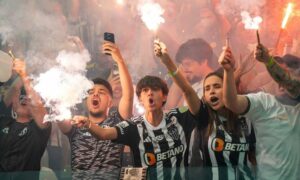The Inter Milan fans turned San Siro into a cauldron. Even before kickoff, the stadium pulsed with chants and flags, welcoming the players with energy that seemed to foreshadow the home team’s dominance. From the opening minutes, Inter set the pace, closing spaces and exploiting the wings with speed. Barcelona, despite their quality, struggled to overcome the Italian defense.
In the first 45 minutes, Inter Milan left no room for their opponents. Lautaro Martínez, even without being at his peak physical condition, opened the scoring at the 20th minute, capitalizing on a precise pass from Dumfries. Near the end of the half, Çalhanoglu extended the lead from a penalty, securing a 2-0 advantage. The match, still ongoing, promises excitement in the second half.
The clash at Giuseppe Meazza, valid for the Champions League semifinal, carries historical weight. After a 3-3 draw in the first leg, Inter seeks a spot in the final with the support of their fans. Below are some highlights from the first half:
- Tactical dominance: Inter shut down the wings, neutralizing Yamal and Raphinha.
- Speed in transitions: Dimarco and Dumfries were key in offensive plays.
- Attacking efficiency: Lautaro and Çalhanoglu capitalized on limited clear chances.
Barcelona, meanwhile, tried to react with moves from Yamal and Pedri but faltered against the solid Italian defense. The game remains open, with the second half potentially shifting the course of qualification.
Initial pressure at San Siro
Inter Milan took the field with an aggressive stance. From the opening whistle, Simone Inzaghi’s team displayed tactical organization, blocking Barcelona’s advances down the flanks. Dimarco, in particular, was a constant obstacle for Yamal, while Dumfries nullified Raphinha. The fans, filling the stadium, drove the team with deafening chants, creating an intimidating atmosphere. In the opening minutes, Inter already showed control, with quick transitions and efficient ball possession.
Barcelona, led by Hansi Flick, attempted to impose their style of play based on short passes and movement. However, the lack of space hindered their offensive actions. Ferran Torres had a chance early on, but the assistant referee flagged offside. The Catalan side, known for their prolific attack with 40 goals in the competition, saw their main weapons neutralized in the first half.
Lautaro Martínez paves the way
At the 20th minute, Inter found the goal that set San Siro ablaze. Dimarco, in a ball-stealing move, dispossessed Dani Olmo in midfield. The ball reached Dumfries, who, with space on the right, delivered a low pass to Lautaro Martínez. The Argentine captain, despite a recent injury history, finished with precision, leaving no chance for goalkeeper Szczesny. The goal marked the start of even greater pressure from Inter.
Lautaro, who was doubtful for the match, showed why he is a cornerstone of Inzaghi’s system. Despite not being at 100%, the striker moved constantly, creating spaces and contributing to playmaking. His presence on the pitch gave the team confidence, as they began to dominate offensive actions. Barcelona, disoriented, struggled to respond.
INTER PENALTY! 🚨#ForzaInter #UCL #InterBarcelona
— Inter ⭐⭐ (@Inter_en) May 6, 2025
Decisive penalty for Inter
Near the break, Inter extended their lead in a controversial moment. At the 43rd minute, Lautaro Martínez was brought down by Cubarsí inside the box. Polish referee Szymon Marciniak, after consulting VAR, confirmed the penalty. Hakan Çalhanoglu, with composure, struck to the right corner as Szczesny dove the opposite way. The 2-0 goal solidified the Italian side’s dominance.
The call sparked complaints from Barcelona players, who questioned the decision. However, the VAR review was clear, confirming Cubarsí’s contact on Lautaro. Inter, already in control, gained even more confidence with the second goal. The fans, ecstatic, turned San Siro into a true spectacle.
Key moments of the first half
The first half was defined by moments that underscored Inter’s dominance. Below is a timeline of the main events:
- 2’: Ferran Torres shoots after a pass from Yamal, but the play is ruled offside.
- 20’: Lautaro Martínez opens the scoring with an assist from Dumfries, following a steal by Dimarco.
- 36’: Çalhanoglu receives a yellow card for a foul on Dani Olmo.
- 43’: Penalty awarded to Inter after Cubarsí fouls Lautaro.
- 45’: Çalhanoglu converts the penalty, making it 2-0 for Inter.
These moments highlight how Inter capitalized on opportunities, while Barcelona struggled to create clear chances. The Italians’ efficiency contrasted with the Catalans’ lack of precision.
Barcelona tries to react without success
Barcelona, despite their technical quality, couldn’t impose their game. Yamal, one of the world’s brightest young talents, attempted dribbles and crosses but was stopped by Dimarco’s marking. Raphinha, the only Brazilian on the pitch, also had a quiet performance, with little room to advance. Pedri and Dani Olmo, in midfield, managed some plays but lacked connection with the forwards.
The Catalan side had only four shots in the first half, compared to Inter’s eight. Possession, though favoring Barcelona at 62%, didn’t translate into real goal-scoring opportunities. The Italian defense, led by Acerbi and Bastoni, was impeccable, cutting out crosses and blocking shots. Szczesny, despite conceding twice, made key saves, like on a Barella shot at the 20th minute.
Inzaghi’s tactics make the difference
Simone Inzaghi, Inter’s coach, opted for a 3-5-2 formation that prioritized defensive solidity and speed on the wings. Dumfries and Dimarco, as wing-backs, were crucial in both defending and supporting the attack. In midfield, Çalhanoglu, Barella, and Mkhitaryan controlled the tempo, preventing Barcelona from finding spaces. The strategy paid off, with Inter dominating transitions and capitalizing on the opponent’s mistakes.
The decision to start Lautaro Martínez, despite the Argentine’s less-than-ideal physical condition, proved correct. The captain not only scored the opener but also actively contributed to pressing. Thuram, his attacking partner, also troubled Barcelona’s defense, though he missed a clear chance in an offside-ruled play.
Numbers that explain the dominance
The first-half statistics reinforce Inter’s superiority. The Italian side had 38% possession but was more effective, with three shots on target compared to Barcelona’s one. Inter also earned three corners, while Barça had two. Tactical discipline was reflected in fouls: four committed by Inter against two by Barcelona.
Another notable stat is passes. Barcelona completed 245 passes with 85% accuracy, while Inter had 125 passes with 66% accuracy. Despite the gap, Inter was more direct, prioritizing vertical plays. These numbers show how the Italian side balanced defense and attack, even with less possession.
Absences limit Barcelona
Barcelona felt the absence of two key players. Alejandro Balde, left-back, and Jules Koundé, right-back, are injured and didn’t travel to Milan. Without them, Hansi Flick opted for Eric García and Gerard Martín at the full-back positions, which compromised defensive solidity. Lewandowski, another recent absentee, is on the bench but didn’t feature in the first half.
The lack of options at full-back left Barcelona vulnerable to Dumfries and Dimarco’s advances. Gerard Martín, in particular, struggled to contain Dumfries, who won most duels on the right. Balde’s absence also limited offensive plays down the left, where Barça is typically more dangerous.
Recent history in the matchup
The clash between Inter Milan and Barcelona carries historical significance in the Champions League. In 2010, Inter, then led by José Mourinho, eliminated Pep Guardiola’s Barça in the semifinals, with a memorable 3-1 aggregate victory. The Italian fans, aware of that feat, brought banners and chants recalling that triumphant campaign, adding pressure on the Catalans.
In the first leg of this semifinal, played in Barcelona, the 3-3 draw showed balance. Inter took a 2-0 lead with goals from Thuram and Dumfries, but Barça fought back with Yamal and Ferran Torres. In the second half, Dumfries scored again, but a Raphinha shot that deflected off Sommer equalized. That result keeps the tie open, with Inter holding the edge for now.
Fans as a game-changer
Inter Milan’s supporters were a spectacle in their own right. Before the match, fans packed the streets around San Siro, greeting the team bus with fireworks and chants. Inside the stadium, the choreographed display in the stands was stunning, with messages of support for the team. This hostile environment made Barcelona’s task even tougher, as they seemed to feel the pressure.
During the first half, the crowd didn’t stop singing, especially after the goals by Lautaro and Çalhanoglu. Every tackle, every Inter advance was celebrated like a goal. This unwavering support has been a key factor in Inter’s campaign, having conceded just five goals in the competition before facing Barcelona.
Refereeing in the spotlight
Polish referee Szymon Marciniak had a busy first half. The penalty call at the 43rd minute drew protests from Barcelona, but the decision was upheld by VAR, led by Dutch official Dennis Higler. Marciniak also issued a yellow card to Çalhanoglu for a foul on Dani Olmo and kept control of the game despite complaints.
Other incidents, like Barcelona’s penalty appeal at the 24th minute for a possible handball by Acerbi, were reviewed by VAR, which opted against a formal review. The refereeing, so far, has been firm, but the penalty controversy may influence the atmosphere in the second half.
What to expect in the second half
With a 2-0 lead, Inter holds the advantage, but the match is far from decided. Barcelona, known for their comeback ability, is likely to return with a more aggressive approach. Hansi Flick may turn to Lewandowski, on the bench, to shift the attack’s dynamic. Bringing on Gavi or Fermín López could also add more energy to the midfield.
Inter, meanwhile, is expected to maintain their defensive solidity and exploit counterattacks. Inzaghi has options like Frattesi and Zielinski on the bench to bolster the midfield if Barcelona presses. The fans, acting as the 12th player, will be a trump card for the Italian side. The second half promises to be thrilling, with a final spot at stake.
Raphinha chasing the top scorer race
Raphinha, the only Brazilian on the pitch, had a quiet first half but remains one of Barcelona’s hopes. With 12 goals in the Champions League, the winger is just one goal shy of tying Guirassy, from Borussia Dortmund, in the competition’s top scorer race. His speed and skill could be decisive in the second half if Barça manages to create more space.
In the first leg, Raphinha was crucial, scoring the equalizer. His performance at San Siro has been limited by Dumfries’ marking, but the No. 11 has the quality to turn the game. Catalan fans hope he can replicate the brilliance of past matches.
Tactical structure in focus
The matchup pits two contrasting tactical setups against each other. Inter’s 3-5-2 prioritizes compactness and quick transitions, with wing-backs who constantly move up and down. Barcelona’s 4-3-3 relies on possession and the creativity of their midfielders and forwards. In the first half, Inzaghi’s setup prevailed, but Flick may adjust his team to reverse the situation.
The tactical difference was clear in the wing play. While Dumfries and Dimarco dominated their duels, Eric García and Gerard Martín struggled to contain Inter’s advances. Barça’s midfield, with De Jong, Pedri, and Olmo, had trouble linking up with Yamal and Ferran Torres, limiting the team’s attacking threat.
Journey to the semifinal
Inter Milan reached the semifinal with a solid campaign. In the league phase, they finished fourth, advancing to the round of 16, where they eliminated Feyenoord. In the quarterfinals, the Italian side overcame Bayern Munich, showcasing defensive strength and attacking efficiency. Until facing Barcelona, Inter had conceded just five goals in the competition.
Barcelona, meanwhile, had the second-best campaign in the league phase, with the competition’s most prolific attack, scoring 40 goals. In the round of 16, the Catalans defeated Benfica, and in the quarterfinals, they eliminated Borussia Dortmund. Despite absences, Barça remains a title favorite but needs to overturn the scoreline in the second half.
The other side of the bracket
While Inter and Barcelona vie for a final spot, the other semifinal tie remains open. Paris Saint-Germain defeated Arsenal 1-0 in the first leg in London. The return leg, set for Wednesday at 4 p.m. in Paris, will determine the opponent of the winner of this clash. The Champions League final promises to be a spectacle, with top-tier teams in contention.
OUR CAPTAIN. WE LEAD!!! 🤩#ForzaInter #UCL #InterBarcelona pic.twitter.com/vDl75R0yAj
— Inter ⭐⭐ (@Inter_en) May 6, 2025
Behind you all the way, lads 👊#ForzaInter #UCL #InterBarcelona pic.twitter.com/5MCD2wozEZ
— Inter ⭐⭐ (@Inter_en) May 6, 2025


The Inter Milan fans turned San Siro into a cauldron. Even before kickoff, the stadium pulsed with chants and flags, welcoming the players with energy that seemed to foreshadow the home team’s dominance. From the opening minutes, Inter set the pace, closing spaces and exploiting the wings with speed. Barcelona, despite their quality, struggled to overcome the Italian defense.
In the first 45 minutes, Inter Milan left no room for their opponents. Lautaro Martínez, even without being at his peak physical condition, opened the scoring at the 20th minute, capitalizing on a precise pass from Dumfries. Near the end of the half, Çalhanoglu extended the lead from a penalty, securing a 2-0 advantage. The match, still ongoing, promises excitement in the second half.
The clash at Giuseppe Meazza, valid for the Champions League semifinal, carries historical weight. After a 3-3 draw in the first leg, Inter seeks a spot in the final with the support of their fans. Below are some highlights from the first half:
- Tactical dominance: Inter shut down the wings, neutralizing Yamal and Raphinha.
- Speed in transitions: Dimarco and Dumfries were key in offensive plays.
- Attacking efficiency: Lautaro and Çalhanoglu capitalized on limited clear chances.
Barcelona, meanwhile, tried to react with moves from Yamal and Pedri but faltered against the solid Italian defense. The game remains open, with the second half potentially shifting the course of qualification.
Initial pressure at San Siro
Inter Milan took the field with an aggressive stance. From the opening whistle, Simone Inzaghi’s team displayed tactical organization, blocking Barcelona’s advances down the flanks. Dimarco, in particular, was a constant obstacle for Yamal, while Dumfries nullified Raphinha. The fans, filling the stadium, drove the team with deafening chants, creating an intimidating atmosphere. In the opening minutes, Inter already showed control, with quick transitions and efficient ball possession.
Barcelona, led by Hansi Flick, attempted to impose their style of play based on short passes and movement. However, the lack of space hindered their offensive actions. Ferran Torres had a chance early on, but the assistant referee flagged offside. The Catalan side, known for their prolific attack with 40 goals in the competition, saw their main weapons neutralized in the first half.
Lautaro Martínez paves the way
At the 20th minute, Inter found the goal that set San Siro ablaze. Dimarco, in a ball-stealing move, dispossessed Dani Olmo in midfield. The ball reached Dumfries, who, with space on the right, delivered a low pass to Lautaro Martínez. The Argentine captain, despite a recent injury history, finished with precision, leaving no chance for goalkeeper Szczesny. The goal marked the start of even greater pressure from Inter.
Lautaro, who was doubtful for the match, showed why he is a cornerstone of Inzaghi’s system. Despite not being at 100%, the striker moved constantly, creating spaces and contributing to playmaking. His presence on the pitch gave the team confidence, as they began to dominate offensive actions. Barcelona, disoriented, struggled to respond.
INTER PENALTY! 🚨#ForzaInter #UCL #InterBarcelona
— Inter ⭐⭐ (@Inter_en) May 6, 2025
Decisive penalty for Inter
Near the break, Inter extended their lead in a controversial moment. At the 43rd minute, Lautaro Martínez was brought down by Cubarsí inside the box. Polish referee Szymon Marciniak, after consulting VAR, confirmed the penalty. Hakan Çalhanoglu, with composure, struck to the right corner as Szczesny dove the opposite way. The 2-0 goal solidified the Italian side’s dominance.
The call sparked complaints from Barcelona players, who questioned the decision. However, the VAR review was clear, confirming Cubarsí’s contact on Lautaro. Inter, already in control, gained even more confidence with the second goal. The fans, ecstatic, turned San Siro into a true spectacle.
Key moments of the first half
The first half was defined by moments that underscored Inter’s dominance. Below is a timeline of the main events:
- 2’: Ferran Torres shoots after a pass from Yamal, but the play is ruled offside.
- 20’: Lautaro Martínez opens the scoring with an assist from Dumfries, following a steal by Dimarco.
- 36’: Çalhanoglu receives a yellow card for a foul on Dani Olmo.
- 43’: Penalty awarded to Inter after Cubarsí fouls Lautaro.
- 45’: Çalhanoglu converts the penalty, making it 2-0 for Inter.
These moments highlight how Inter capitalized on opportunities, while Barcelona struggled to create clear chances. The Italians’ efficiency contrasted with the Catalans’ lack of precision.
Barcelona tries to react without success
Barcelona, despite their technical quality, couldn’t impose their game. Yamal, one of the world’s brightest young talents, attempted dribbles and crosses but was stopped by Dimarco’s marking. Raphinha, the only Brazilian on the pitch, also had a quiet performance, with little room to advance. Pedri and Dani Olmo, in midfield, managed some plays but lacked connection with the forwards.
The Catalan side had only four shots in the first half, compared to Inter’s eight. Possession, though favoring Barcelona at 62%, didn’t translate into real goal-scoring opportunities. The Italian defense, led by Acerbi and Bastoni, was impeccable, cutting out crosses and blocking shots. Szczesny, despite conceding twice, made key saves, like on a Barella shot at the 20th minute.
Inzaghi’s tactics make the difference
Simone Inzaghi, Inter’s coach, opted for a 3-5-2 formation that prioritized defensive solidity and speed on the wings. Dumfries and Dimarco, as wing-backs, were crucial in both defending and supporting the attack. In midfield, Çalhanoglu, Barella, and Mkhitaryan controlled the tempo, preventing Barcelona from finding spaces. The strategy paid off, with Inter dominating transitions and capitalizing on the opponent’s mistakes.
The decision to start Lautaro Martínez, despite the Argentine’s less-than-ideal physical condition, proved correct. The captain not only scored the opener but also actively contributed to pressing. Thuram, his attacking partner, also troubled Barcelona’s defense, though he missed a clear chance in an offside-ruled play.
Numbers that explain the dominance
The first-half statistics reinforce Inter’s superiority. The Italian side had 38% possession but was more effective, with three shots on target compared to Barcelona’s one. Inter also earned three corners, while Barça had two. Tactical discipline was reflected in fouls: four committed by Inter against two by Barcelona.
Another notable stat is passes. Barcelona completed 245 passes with 85% accuracy, while Inter had 125 passes with 66% accuracy. Despite the gap, Inter was more direct, prioritizing vertical plays. These numbers show how the Italian side balanced defense and attack, even with less possession.
Absences limit Barcelona
Barcelona felt the absence of two key players. Alejandro Balde, left-back, and Jules Koundé, right-back, are injured and didn’t travel to Milan. Without them, Hansi Flick opted for Eric García and Gerard Martín at the full-back positions, which compromised defensive solidity. Lewandowski, another recent absentee, is on the bench but didn’t feature in the first half.
The lack of options at full-back left Barcelona vulnerable to Dumfries and Dimarco’s advances. Gerard Martín, in particular, struggled to contain Dumfries, who won most duels on the right. Balde’s absence also limited offensive plays down the left, where Barça is typically more dangerous.
Recent history in the matchup
The clash between Inter Milan and Barcelona carries historical significance in the Champions League. In 2010, Inter, then led by José Mourinho, eliminated Pep Guardiola’s Barça in the semifinals, with a memorable 3-1 aggregate victory. The Italian fans, aware of that feat, brought banners and chants recalling that triumphant campaign, adding pressure on the Catalans.
In the first leg of this semifinal, played in Barcelona, the 3-3 draw showed balance. Inter took a 2-0 lead with goals from Thuram and Dumfries, but Barça fought back with Yamal and Ferran Torres. In the second half, Dumfries scored again, but a Raphinha shot that deflected off Sommer equalized. That result keeps the tie open, with Inter holding the edge for now.
Fans as a game-changer
Inter Milan’s supporters were a spectacle in their own right. Before the match, fans packed the streets around San Siro, greeting the team bus with fireworks and chants. Inside the stadium, the choreographed display in the stands was stunning, with messages of support for the team. This hostile environment made Barcelona’s task even tougher, as they seemed to feel the pressure.
During the first half, the crowd didn’t stop singing, especially after the goals by Lautaro and Çalhanoglu. Every tackle, every Inter advance was celebrated like a goal. This unwavering support has been a key factor in Inter’s campaign, having conceded just five goals in the competition before facing Barcelona.
Refereeing in the spotlight
Polish referee Szymon Marciniak had a busy first half. The penalty call at the 43rd minute drew protests from Barcelona, but the decision was upheld by VAR, led by Dutch official Dennis Higler. Marciniak also issued a yellow card to Çalhanoglu for a foul on Dani Olmo and kept control of the game despite complaints.
Other incidents, like Barcelona’s penalty appeal at the 24th minute for a possible handball by Acerbi, were reviewed by VAR, which opted against a formal review. The refereeing, so far, has been firm, but the penalty controversy may influence the atmosphere in the second half.
What to expect in the second half
With a 2-0 lead, Inter holds the advantage, but the match is far from decided. Barcelona, known for their comeback ability, is likely to return with a more aggressive approach. Hansi Flick may turn to Lewandowski, on the bench, to shift the attack’s dynamic. Bringing on Gavi or Fermín López could also add more energy to the midfield.
Inter, meanwhile, is expected to maintain their defensive solidity and exploit counterattacks. Inzaghi has options like Frattesi and Zielinski on the bench to bolster the midfield if Barcelona presses. The fans, acting as the 12th player, will be a trump card for the Italian side. The second half promises to be thrilling, with a final spot at stake.
Raphinha chasing the top scorer race
Raphinha, the only Brazilian on the pitch, had a quiet first half but remains one of Barcelona’s hopes. With 12 goals in the Champions League, the winger is just one goal shy of tying Guirassy, from Borussia Dortmund, in the competition’s top scorer race. His speed and skill could be decisive in the second half if Barça manages to create more space.
In the first leg, Raphinha was crucial, scoring the equalizer. His performance at San Siro has been limited by Dumfries’ marking, but the No. 11 has the quality to turn the game. Catalan fans hope he can replicate the brilliance of past matches.
Tactical structure in focus
The matchup pits two contrasting tactical setups against each other. Inter’s 3-5-2 prioritizes compactness and quick transitions, with wing-backs who constantly move up and down. Barcelona’s 4-3-3 relies on possession and the creativity of their midfielders and forwards. In the first half, Inzaghi’s setup prevailed, but Flick may adjust his team to reverse the situation.
The tactical difference was clear in the wing play. While Dumfries and Dimarco dominated their duels, Eric García and Gerard Martín struggled to contain Inter’s advances. Barça’s midfield, with De Jong, Pedri, and Olmo, had trouble linking up with Yamal and Ferran Torres, limiting the team’s attacking threat.
Journey to the semifinal
Inter Milan reached the semifinal with a solid campaign. In the league phase, they finished fourth, advancing to the round of 16, where they eliminated Feyenoord. In the quarterfinals, the Italian side overcame Bayern Munich, showcasing defensive strength and attacking efficiency. Until facing Barcelona, Inter had conceded just five goals in the competition.
Barcelona, meanwhile, had the second-best campaign in the league phase, with the competition’s most prolific attack, scoring 40 goals. In the round of 16, the Catalans defeated Benfica, and in the quarterfinals, they eliminated Borussia Dortmund. Despite absences, Barça remains a title favorite but needs to overturn the scoreline in the second half.
The other side of the bracket
While Inter and Barcelona vie for a final spot, the other semifinal tie remains open. Paris Saint-Germain defeated Arsenal 1-0 in the first leg in London. The return leg, set for Wednesday at 4 p.m. in Paris, will determine the opponent of the winner of this clash. The Champions League final promises to be a spectacle, with top-tier teams in contention.
OUR CAPTAIN. WE LEAD!!! 🤩#ForzaInter #UCL #InterBarcelona pic.twitter.com/vDl75R0yAj
— Inter ⭐⭐ (@Inter_en) May 6, 2025
Behind you all the way, lads 👊#ForzaInter #UCL #InterBarcelona pic.twitter.com/5MCD2wozEZ
— Inter ⭐⭐ (@Inter_en) May 6, 2025








